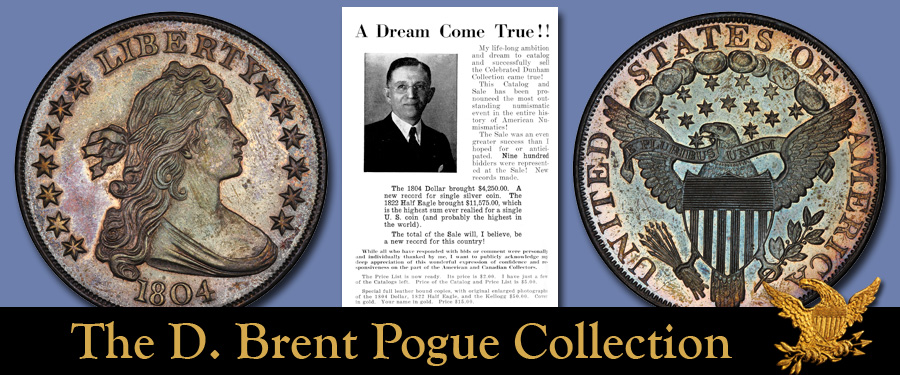
Second Finest Known!
The 1804 silver dollar is
the very definition of the icon of American numismatics. For over 150
years more has been written about this rarity than for the next several
combined!
When it was crowned as
“king” we don’t know. George G. Evans in his popular Illustrated History of
the United States Mint, published in the 1880s and 1890s in multiple
editions, commented, “This coin among collectors is known as the ‘king of
American rarities.’”
In their 1906 catalog of
the Major W.B. Wetmore collection the Chapman brothers noted, “There are many
very desirable coins here offered, notably the Grand Old King of American
coins, the 1804 dollar, a coin the possession of which has afforded Major
Wetmore much pleasure for nearly 30 years.”
The grand prize for the
deification of the 1804 dollar surely goes to B. Max Mehl in his description of
the William Forrester Dunham Collection coin in 1941:
“In all the history of
numismatics of the entire world, there is not today and there never has been a
single coin which was and is the subject of so much romance, interest, comment,
and upon which so much has been written and so much talked about and discussed
as the United States silver dollar of 1804.
“While there may be coins
of greater rarity (based upon the number of specimens known), none is as famous
as the dollar of 1804! This is due to the fact that this great coin was the
first coin of United States mintage to have been recognized as the rarest coin
of the United States, from the very beginning of American numismatics, more
than one hundred years ago. And it is today, as it always has been, the best
known and most sought-after coin, not only among collectors, but among the
public in general as well.”
For well over a century
the possession of an 1804 silver dollar in a collection has bestowed an aura of
glory upon its owner. More than any other single coin, the 1804 dollar has
attracted a lot of attention in numismatic circles. Three books have been
written and posters have been printed showing it. From time to time specimens
have been placed on display at museums such as the Smithsonian Institution, the
American Numismatic Association, the American Numismatic Society, and
elsewhere. The exhibit of an 1804 dollar at a convention has always been a
prime drawing card. Crowds gather around!
There are eight known
Class I or “original” 1804 dollars—struck from Proof dies in 1834 for
diplomatic presentation. Three are in museums: the National Numismatic
Collection at the Smithsonian Institution (impaired Proof), the American
Numismatic Association Museum in Colorado Springs (VF-30), and the Durham
Western Heritage Museum in Omaha (Proof-64 with friction in the fields).
The Dexter Specimen, the
coin to be offered in The D. Brent Pogue Collection Part V set a record price
for a coin sold at public auction in 1989 when it just missed realizing a
seven-figure price, the million-dollar barrier which would not be broken until
1996 with the sale of the Eliasberg 1913 Liberty nickel.
You are invited to be the next owner! We
congratulate in advance the successful bidder. You will join this fantastic
roster of those who have bought and sold this identical coin:
From S. Hudson and Henry
Chapman in or before 1884, possibly obtained from a Mint official who requested
privacy. William E. DuBois, co-curator of the Mint Cabinet for many years is a
good candidate. Sold by them at auction on May 14, 1885, stating that it had
come from a sale held in Berlin, Germany, by Adolph Weyl in October 1884, lot
159. However, the Weyl coin is different. Particulars are given by Eric P.
Newman in The Fantastic 1804 Dollar, 1962, co-authored with Kenneth
Bressett. Returning to the Dexter coin it was sold to the following; J.W.
Scott, proprietor of the Scott Stamp & Coin Co., New York, agent for the
following; James Vila Dexter, Denver, Colorado. He seems to have taken a tiny D
punch and placed his initial on a cloud on the reverse. Apparently, he marked
certain other of his coins as well, tying them to his collection; 1899-1903 in
the Dexter estate; On November 5, 1903, Roland G. Parvin,, executor of the
Dexter estate, sold the coin to the following; H.G. Brown, Portland, Oregon.
October 11. 1904: Lyman H. Low, Part I of the Brown Collection, lot 431;
William Forrester Dunham, Chicago pharmacist, until 1939, sold with his
collection to; B. Max Mehl, who added it to his inventory, offering rarities by
private treaty to John Work Garrett, Charles M. Williams, and others. Sold
privately to the following sometime between 1939 and early 1941, although it
was showcased in the May 1941 catalog and claimed to have been sold for a
record price; Charles M. Williams, Cincinnati insurance executive who sold his
collection intact in 1949 to the following; Numismatic Gallery; 1949 by private
treaty to the following; Harold Bareford; our sale of the Bareford Collection,
October 22-23, 1981, lot 424; RARCOA (Ed Milas), sold in 1985 to the following;
Leon Hendrickson in partnership with George Weingart; RARCOA. July 7, 1989,
Auction ’89, lot 247; American Rare Coin Fund, L.P., Hugh Sconyers, financial
manager, Kevin Lipton, numismatic manager; sold in the early 1990s to the
following; Northern California collector; Superior Galleries sale, May 30-31,
1994; lot 761; Harlan White, proprietor of the Old Coin Shop, San Diego,
California; Holecek Family Trust; Our 65th Anniversary Sale, October 2000, lot
1167; D. Brent Pogue. [This space reserved for you!]





